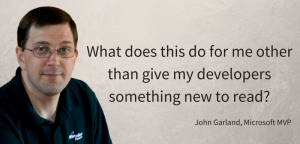 What will Microsoft’s evolution of its development ecosystem offer software companies and developers? One of the keynote speakers at the Izenda Embedded BI Conference plans to update them with news of Azure, .NET Core, .NET Standard and the full .NET Framework.
What will Microsoft’s evolution of its development ecosystem offer software companies and developers? One of the keynote speakers at the Izenda Embedded BI Conference plans to update them with news of Azure, .NET Core, .NET Standard and the full .NET Framework.
John Garland, a principal consultant and instructor at Wintellect, intends to put this in context for what it means to developers now and in the near future.
“There’s all these buzzwords around, cloud, containers, Azure, .NET Core and Standard and everything else. What does this do for me other than give my developers something new to read?” he said.
In the near term, developers, project managers and software company executives are asking how close attention they need to pay to the evolving .NET ecosystem. They want to know if it can be put in a context that shows how it works together and if it makes sense for their business. Garland plans to address these topics during his presentation on Jan. 24 so software companies can evaluate their product roadmaps to figure out when it’s time to make the switch.
Garland said discussion continues on what .NET Standard 2 brings to developers. He said that while the .NET Standard 1 versions were more introductory, .NET Standard will move the platform forward significantly. Developers can start thinking about replacing things like PCLs that they used to deploy or write code to be consumed and deployed in many places.
Although it’s still early, the development world feels the impact of .NET Core, and, in particular, .NET Standard. But not long after the Izenda Embedded BI User Conference, developers will see interesting times.
Garland said hopefully .NET Standard 2 will bring in a shim to allow more abilities from .NET Core and .NET Framework. Part of. .NET Standard 2 includes a Compatibility Shim which allows you to consume .NET (Full) Framework binaries from .NET Standard libraries. Note that there are caveats here. However, the benefit is that this allows you to move existing libraries forward even if you don’t directly control their dependencies – if those dependencies are built within certain boundaries.
Referencing things across the divides will make it a bit more real. that the API surface of .NET Standard 2 is going to be much larger than that of .NET Standard 1 – so some things were difficult (or impossible) in version 1, but now they will be getting easier with V2.
Decision makers at software companies want to know where on the adoption curve this all fits. Is it the early adopters’ phase, or somewhere else? Should they adopt use of .NET Core and .NET Standard 1 now, or should they wait for additional updates such as the general release of .NET Standard 2?
Garland, a Microsoft MVP and Microsoft Azure Advisor, will offer advice so software companies can more easily decide when they might adopt .NET Core.
He said the evolving .NET development ecosystem increases the value position in Azure as well. Take containers as an example. .NET Core reaches over to new platforms such as Linux, enabling easy deployment in containers. So now developers can start to treat their deployment surface as replaceable since they can just spin up another server.
Which cloud is right for your team – Azure or AWS?
Part of this transformation is for IT to stop thinking of their servers as “pets” and instead enabling them to more treat them like “cattle.” In the past, IT would provision servers with majestic names like “Thor” or “Chyron”. They nurtured and fed the server and went to great pains to take care of it. Now, with the easier deployment model, these containers are just enclosed units in a server somewhere in a data center.
But now, with easy deployment, developers and IT treat servers like cattle. With Azure, developers provision a server. Containers are just enclosed units in a server somewhere in a data center. If a server acts badly today, you throw it away and create another one – hopefully, in the fraction of a second this takes nobody will notice. “Why reboot the server when you can just replace it?”
So you can quickly set up an environment to develop against and test. You just create the system that you need on the fly. Garland said we could do a lot of this all along. But the amount of labor and the challenges involved fostered a debate on whether it was worth the effort. The lower level of effort shifts the cost/benefit ratio to the benefit side of things.
Challenges still exist. He said before developers could ignore some of these technologies. Those critical things you learned four years ago now are just books taking up space on your bookshelf. But now they need to pay attention and learn about this evolved development ecosystem.
.NET Core has arrived and with it comes a new future. Now we need to take the time to evolve along with this development ecosystem.
Join us at the Izenda Embedded BI Users Conference to hear Garland’s advice on how to evaluate the .NET development ecosystem. Attendees will learn its current status during Garland’s presentation, along with the near-term roadmap that it’s following. Take the opportunity to learn what it can do for your company so you can decide how to approach using it.
Read our blog on “pure” HTML5
Follow Izenda on social media for the latest on technology and business intelligence:
![]()
![]()
![]()

